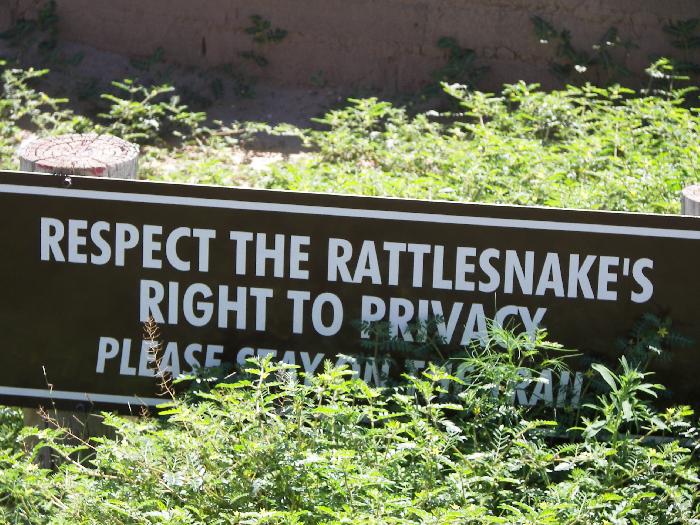Snake Bites to Dogs: Prevention and Treatment

Snake bites to dogs can range from being nothing more than a nuisance to being a fatal injury. For those that live in rattlesnake territory, or regularly hike where rattlesnakes live, with their dog, an encounter with these reptiles is inevitable. You can take steps now to prevent a deadly encounter between a rattlesnake and your dog. But even with preventative measures, you should also know what to do if your dog is bit by a snake.
Discourage Snakes in the Yard
If you live in snake country, especially if you have venomous rattlers, make sure your dogs yard is not snake friendly. Snakes hide in debris piles and tall grasses, so keep your yard free of debris and keep the grass mowed short. Also, keep the yard free of food for the rattlesnakes. Rattlesnakes eat lizards, rodents, and rabbits. Removing woodpiles, debris, and fallen fruit will discourage rodents from moving in. You can also install a rattlesnake proof fence, which is a short fence partially buried in the ground and a top that angles towards the outside of the yard. Close off any holes or other entrances to under the house and porch.
Keep Your Pooch on Leash
The easiest and most effective way to prevent snake bites to dogs is to keep your dog on a leash, especially if you know he has an affinity for snake holes and wiggly creatures. Keep your dog next to you at all times while hiking and the only rattlesnakes he can come in contact with are ones you inadvertently get to close to. Stay on cleared hiking trails and paths and you will probably see the rattlesnake long before you and your dog get too close. Leashing your dog will also protect him from encounters with other wildlife, a safety benefit for both your dog and the wildlife.
Encountering a Rattlesnake with Your Canine
If or when you and your pooch do encounter a rattlesnake, first freeze and identify where the snake is located before making a move. Then move you and your dog to give it a wide birth of at least 10 feet. You can then back away. Loud noises wont chase the snake away because they do not hear sounds through the air, but rather feel vibrations from the ground. Stomping on the ground as you move away from the snake or making other ground vibrations may help the snake to move away from you. It helps to carry a walking stick when hiking in rattlesnake territory. Then you can bang the ground with your stick to scare it off. Snakes are not known to chase anything larger than them.
Rattlesnake Vaccination Shots for Dogs
There is a dog rattlesnake vaccine you can get for your canine. This vaccine is formulated to specifically protect canines from the Western diamondback rattlesnake (Crotalus atrox) venom. But it is believe to provide some protection against other sn
ake venoms that have similar characteristics. These include the western rattlesnakes (Crotalus viridis) and the Crotalus viridis subspecies, as well as the sidewinder, timber rattlesnake, massissauga rattlesnake, and copperhead according to the manufacturers website. The rattlesnake vaccination shots for dogs does not protect against water moccasin, Mojave rattlesnake, or coral snake venom, which have a different type of venom.
The vaccine stimulates the body to make antibodies to the snake venom. If a vaccinated dog does get bit, then the dogs immune system will be able to neutralize the venom. However, you should know that the vaccine does not protect dogs 100% against the effects of rattlesnake venom. Vaccinated dogs should not experience the severe swelling, pain, and tissue damage that an unvaccinated dog would experience. But if your dog is bitten by a rattlesnake, he should receive veterinary care immediately, even if vaccinated.
Initially, your dog will need two to three rattlesnake vaccination shots over the course of four to six weeks for it to take effect. A booster is needed every 6 to 12 months. If you live or regularly visit an area with rattlesnakes, speak with your veterinarian to find out if the rattlesnake vaccine is a good idea for your dog.
Rattlesnake Aversion Training
Also referred to as snake avoidance training, this dog training technique teaches a dog that rattlesnakes are dangerous. Through professional training, the dog learns that the sight, sound, and smell of a rattlesnake are to be avoided. Because dogs have a much greater sense of smell, a well trained dog may even warn you of an unseen rattlesnake along the path.
Professional dog trainers experienced with aversion training should only do this type of training. If you are interested in rattlesnake aversion training, seek out a trainer that uses live snakes and training techniques that are human to both the canine and the snake. The use of live rattlesnakes, preferably of the species your dog is likely to encounter at home or when hiking, is necessary to teach dogs what they smell like. Each snake species, dead snakes, and live snakes all smell different. Therefore, rattlesnake aversion training needs to involve live rattlesnakes and be taught only by professional rattlesnake avoidance trainers.
Treatment of Snake Bites to Dogs
Fortunately, many venomous snake bites to dogs (and humans) are dry bites. This is when the rattlesnake bites but does not inject any venom. The most serious complication of a dry bite from a non-venomous snake is infection from being bit by another animal. Venomous bites can cause swelling, pain, disrupt circulation, uncontrolled bleeding, and in some cases (depending on the species of snake) paralysis.
Also fortunately, most dogs that receive veterinary care do survive rattlesnake bites. If your dog has been bitten by any snake, do take him to your veterinarian as soon as you can; do not try to treat the wound yourself. You can wash it with soap and water if necessary. Any snake bite to dogs will at a minimum need cleaning to prevent infection and a quick check to determine if a fang was left in your dog (yes, that does happen). Canines bitten by a venomous snake, even those dogs that are vaccinated, will need veterinary monitoring and possibly further supportive care, such as IV fluids or antivenin.
Copyright Notice: This is copyrighted material. No part may be reproduced in anyway by any other party. If you have seen any part of this article on other sites, then it has illegally been plagiarized.
- Keep Your Pets Safe From Poisonous Creatures
By Ruthie Bently Growing up in northern Illinois, I didn’t see many venomous creatures, though my friends and I found a nest of baby rattlesnakes one day under a railroad trestle; we figured they’d fallen off a train car passing overhead. While venomous...
- Snake Aversion Therapy For Dogs
Spring is in the air and with this beautiful season follows the arrival of rattlesnakes. If you live in the US, you’ve probably had at least one experience with snakes, and if you live in the Southwest, you’ve probably had a few. If you’re out...
- World’s Most Colorful But Venomous Snakes Ii
The colorful and bright coloration of these creatures are indications that they are dangerous and deadly. Their bites are considerably fatal. Mangrove Pit Viper (Trimeresurus purpureomaculatus) Image Source The colorful Mangrove Pit Viper is a beauty...
- The World's Most Colorful Snakes
The World's Most Colorful Snakes Twenty species of the most colorful snakes in the world. There are 15 families of snake, 456 genera and there are 2,900 species. The smallest snake, the Thread snake is just 10 cm long and the longest, Python...
- The Most Unusual Facts About Amazing Snakes
Snakes are amongst the most dreaded animals in the world. A number of snake species are venomous and can be extremely fatal to humans. Some species are also extremely large while others are brightly colorful. Some snake species possess incredibly unique...
